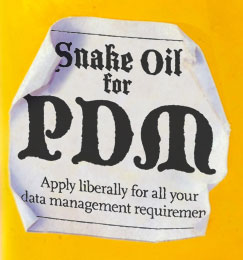Making the decision to deploy a Product Document Management (PDM) system seems easy enough. To actually pick the correct system, deploy it and maintain it, in a mixed environment, without having it control you, is the hard part.
We live highly digital lives these days and while we are not totally paperless, the originals of our work documents are now nearly always computer-generated. We are producing important business information all the time and with the move to modelling, the CAD file format is a major source of product manufacturing information, from simple Bill of Materials (BOM) to tolerance information and CNC toolpaths. Today’s CAD systems go way beyond merely documenting our product ideas and there is a big movement to liberate and distribute this information on-demand to project participants all over the globe.
While our reliance on paper-based docs lead to the invention of the filing cabinet and the plan chest, digital documents required an equivalent and thus Product Document Management (PDM) systems were born – a central place to store project-related digital documents from multiple computer applications. In principle this sounds straightforward enough but, in reality, finding a single PDM solution to handle every business need can prove to be elusive and the tighter the system is integrated the more restrictive it can be on your businesses use in applications.
In the last 15 years, there have unfortunately been many failed implementations of PDM with software developers failing to deliver on their feature/function promises, dealers failing to implement and customer expectations not matching what finally got delivered. In the early days, the high-cost of PDM, in terms of both software and implementation, led to some protracted multi-year deployments at large engineering firms, while trying to ‘get it right’, as nobody wanted to lose face having signed off substantial budgets on the promise of improved efficiency. This understandably led to a jaded view of the PDM market from customers, dealers and consultants – an outlook that persisted for many years.
In the last five years most of the CAD vendors have moved into the management side of the market by offering simple vaulting systems and applications which offer ‘out-of-the-box’ basic PDM. These are typically good for their own CAD file formats but not particularly broad in scope or expandable. While this has increased adoption of PDM within engineering workgroups, a company-wide PDM is still a much more complex area to address.
Dealers multi-CAD and PDM
In researching this piece I talked to a number of dealers and found that there was a common thought when it came to selling PDM to customers. That one common thought was one of risk and its avoidance. In the early days of PDM, most CAD dealers jumped at the new opportunity of selling management systems to their installed bases, only to find the systems they were selling were limited, buggy or were so problematic that the dealer’s profit margin was eaten up with technical support.
This caused serious customer relationship issues, undermined the dealer’s own faith in the PDM system they were selling (typically created by the CAD vendor they were affiliated to) and has impacted the way they have approached PDM enquiries ever since.

Truly independent advice on PDM is hard to come by. It’s like going to a pensions advisor that only has one policy to sell: You only get what they have on the menu
While implementations of PDM may vary greatly from customer to customer, dealers appear to only really want to deploy what they know has worked in previous instances, and while this may lead to some very basic installations, the most important criteria is that they deliver to the expectations they set, as opposed to the expectations of higher-level functionality a PDM developer may actually promote their product on.
When it comes down to managing data from multiple CAD systems, the most common response I received was that the best solution is to deploy multiple PDM systems. By choosing the PDM variant from each vendor to manage the file output from their respective systems you would ensure maximum compatibility and functionality, and you would expect companies like SolidWorks to be in the best position to leverage the information within its files and PTC to best work with Pro/Engineer. While each CAD vendor will swear blind that they have plug-ins to enable their PDM tool to work with CAD data from other CAD vendor’s products, the reality is that at best there will be a lag in support for changing file format. However, there are often other more fundamental problems like lack of support or reduced depth of access.
It’s not the cheapest solution and some would say it’s overkill but dealers feel that it’s a solution that works. If you had three core CAD systems, you would deploy three PDM vaults and would in turn hook those into a master database or business management system. The experience here dictates that it’s easier to map and link multiples than to get one centralised system.
If a PDM implementation goes awry, it’s not uncommon for the customer to change dealer and in some circumstances change CAD vendor and core modelling application. If the PDM from the CAD vendor can’t manage its own data, then who else is going to be able to sort out the company’s data needs? So, failure and past experience have lead to the dealer’s ultra-cautious approach to PDM sales. One dealer explained to me that if a customer doesn’t want to deploy the PDM system in the way that the dealer could assure it would work, they would sooner walk away from the deal and leave it to someone else than take on the risk.
Also worthy of note here is that the way the dealer networks have been set up and managed. It’s rather difficult to find a dealer who has any real choice in which PDM system he will sell. SolidWorks resellers tend to sell SolidWorks’ PDM application (or those of its parent, Dassault Systemes); Autodesk dealers tend to promote Product Stream or Vault from Autodesk and, well, the list goes on. Truly independent advice is hard to come by. It’s like going to a pensions advisor that only has one policy to sell: You only get what they have on the menu.
Vendors and PDM
There are a number of dedicated PDM developers that either sell direct or market directly to users. In these instances they tend to be a lot more bullish about the capabilities of their PDM solution and openly market suites of plug-ins for CAD file formats, as well as other systems such as SAP.
At this end of the market more elaborate solutions may be employed together with a requirement for consultancy and lengthy deployment. Also, the bias on a company-wide implementation would take into account more of the generic business needs and the IT department’s view on company standards and data vaulting. This in itself can mean that the specific requirements for CAD and manufacturing data get pushed further down the PDM checklist.
Upgrade cycle
If you have a number of different CAD systems, and you choose to deploy a single PDM system, or even if you end up deploying a number of PDM systems and link these to a master system, there is a massive issue of product upgrade cycles to take into consideration.
It’s unlikely but possible that at the start of the project the CAD and PDM system might get up and running and work totally as described in the sales pitch. However, software is a moving target and each Operating System, CAD application, CAD add-on and PDM system get revised at different times. Your entire product lifecycle software solution is like a wall that occasionally needs to have bricks replaced. As they may all be from different vendors and different sizes this can cause serious multi-year deployment problems.#
CAD system upgrades seem to vary from yearly to once every three or so years. As CAD is a strategic and important element of product design, it’s expected that you would want to upgrade within the year when the new ‘more powerful’ software comes out.
However, with a tight PDM integration, support for a new file format or new CAD capabilities will more than probably lag behind the new CAD version, which could actually delay deployment of new CAD tools until the PDM system has been enabled to support it. You would hope that PDM solutions for the CAD vendors would increment at the same time as their CAD product but this unfortunately hasn’t always been the case and support for legacy formats is an important issue.
At this point, especially with various levels of integration or bespoke work, somehow your PDM system can become the baseline application that rules when and what can be upgraded within your whole product development system. This can be amplified by hooking into ERP/MRP systems that are updated even less frequently.
Conclusion
The PDM market has been typified by unfulfilled promises, expensive mistakes or getting benefits to the detriment of limiting upgrades and enhancements.
A few years ago I attended an event at the Fraunhofer Institute in Berlin, where I talked with an engineer from Volkswagen. German companies are very process-centric and big proponents of PDM and Product Lifecycle Management (PLM) and Volkswagen, as you would expect, was no different.
However, what was interesting was the view that the company did not want to hand over its process to any one vendor and had decided to keep its systems multi-CAD and mixed PDM. While it would undoubtedly be easier to have everything supplied by one CAD/PDM vendor, the company would be at the mercy of the PDM system that had been installed and might not be free to install best-in-class applications. To me it made perfect sense.
From talking with dealers, multi-CAD companies cannot expect a one-stop shop, offering equal capabilities on all CAD formats. Once a PDM system is in place, a protracted upgrade path of systems will be a likely outcome as all products are on different upgrade cycles. To keep the whole product development system working this may mean skipping releases of certain software to keep compatibility.
The best news I could find concerning today’s management systems is that thanks to XML and standards like Microsoft’s Sharepoint it’s now much easier to aggregate information form disparate systems, pull this information together and package it up in bespoke company ‘dashboards’. So maybe document silos and a federated approach to document management will give the quickest return and are the fastest ways to integrate.
{encode=”martyn@x3dmedia.com” title=”martyn@x3dmedia.com”}

Martyn Day ponders the PDM dilemma






